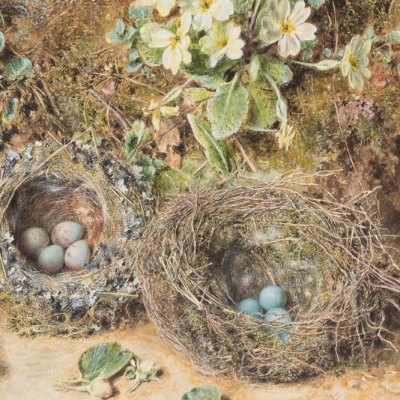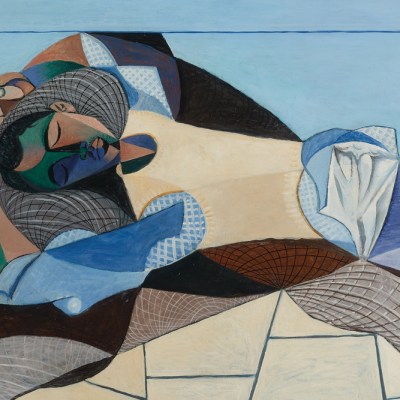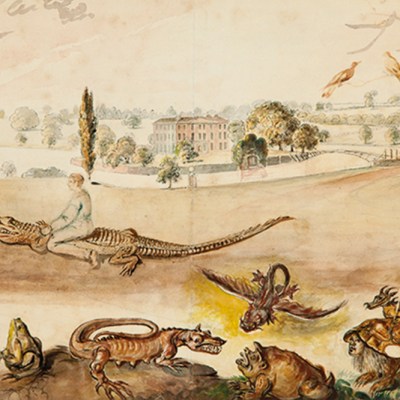From the November 2025 issue of Apollo. Preview and subscribe here.
In Samuel Palmer’s painting In a Shoreham Garden (c. 1830), the viewer is struck by the stillness. Like the best gardens, it is somewhere to stop, to escape from the world: a place where the everyday hum is dimmed. Gardens slow people down, so that they have time to stare and think.
When he was homesick on the streets of London, Yeats dreamed of retreating to his imagined plot on the isle of Innisfree, writing ‘And I shall have some peace there, for peace comes dropping slow.’ Equally fed up with the filth and grime of city life, in the mid 1820s the young Palmer left the capital for rural Kent, in the company of like-minded friends who all yearned, like Yeats, for a return to a simpler, quieter life. Their aim was to recapture the spiritual radiance of the Middle Ages. They called themselves the Ancients. They might now be labelled ‘dropouts’, but they were fired by the idealism of youth and they thought that they could make the world a better place.
For the few years he was there, Palmer walked, talked and dreamed in between painting his idyll. For him, Shoreham was always surrounded by a halo of light. From the right of his garden, the bright sun shimmers as it gleams on the trunk of the tree. The impasto on the blossom is so thick that it looks as though the picture was painted in oils, but it is in fact a work in watercolour and gouache. The painting represents one of those heart-stopping moments when it is hard to believe that the world can be so beautiful – that after a long winter, spring has at last arrived and the garden is coming to life again. And there, behind the tree, a figure stands, paused to gaze at the blossom, as we in turn gaze at her, sharing that long-ago moment of wonder. It’s an idealised scene, mystic and dreamy, part pagan worship, part familiar delight, but it shows us a moment which, two centuries on, can still happen to anyone.

I think I respond more to minor works than major ones, and especially to those artists who, like Palmer, could conjure that mysterious refuge that is the natural world. Some of my favourite artists, who are part of a particularly English lyric, mystic tradition – such as Paul Nash, David Jones, the etcher F.L. Griggs or the young Graham Sutherland – were inspired by a major exhibition of Palmer’s largely forgotten work in 1926. The photographs of James Ravilious, son of Eric, also sometimes have that otherworldly quality. In all these works there are element of strangeness: what on the surface looks like an ordinary scene has a suggestion of unreality. Once, in my last garden, I came upon two visitors whispering and I asked if they were all right. ‘We don’t want to break the spell,’ they answered. Palmer’s visionary paintings are, for me, spell-binding.
If I had an even smaller garden than my present one, I would always want the hint of an orchard. Just one apple tree would be enough, because it really is a miracle to own any tree that paints itself with foaming blossom in spring and then swells with fruit in autumn. Palmer’s The Magic Apple Tree (1830) in the Fitzwilliam in Cambridge is lovely, but I like the Shoreham garden tree better, because the promise of fruit holds so much more than the sight of scarlet windfalls on the ground. I sometimes wonder if the Shoreham tree was not an apple but a pear. Pear blossom tends to be larger and pinker than apple and the shape of the tree more conical. Christianity identifies the apple tree as the tree of knowledge, but in Celtic and Norse mythology it represents immortality.
Times are troubled now. Cities may be cleaner than they were when Palmer or Yeats made their escape, but horrible things are still happening all over the world. Now more than ever is it tempting to retreat from an alien world to the solace of the garden, to believe that somewhere a perfect radiant place exists, where all will be well and all manner of things will be well, and where we might at last feel it ‘in the deep hearts core’.
From the November 2025 issue of Apollo. Preview and subscribe here.


